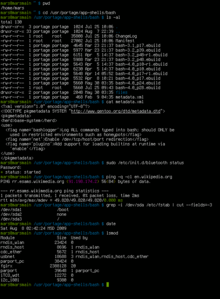Operating Systems: Role of the operating system
The operating system acts as an interface between the hardware and the programs requesting I/O. It is the most fundamental of all system software programs.
Responsibilities of the OS include:
- Hiding the complexities of hardware from the user.
- Managing between the hardware's resources which include the processors, memory, data storage and I/O devices.
- Handling "interrupts" generated by the I/O controllers.
- Sharing of I/O between many programs using the CPU.
There are two types of software:
- System Software - programs that manage the operation of a computer.
- Application Software - programs that help the user perform a particular task.
User Interfaces
[edit | edit source]The User Interface is the interaction between the User and the Machine, letting the user send commands with the expected results. Two forms of the Interface User are the Command Line Interface and the Graphical User Interface.
Command Line Interface (CLI)
[edit | edit source]
The more primitive User Interface, the user would type in a line of command or a single word followed by pressing the Return key. The computer then willingly follows that exact command, informing the user of its progress. For example, the user may want to type in the command to print a document. The user will type the statement Print, then the name of the Printer and finally the name of the file to be printed:
print [/d:Printer] [Drive:][Path] FileName [ ...]
Pros
Cons
Graphical User Interface (GUI)
[edit | edit source]
The GUI is made up of boxes or Windows which will display as an array of usually colourful tiny blocks called Pixels, and a group of pixels is a called an image. The maximum number of colours that can be used are called the Graphics. This User interface will display a Main window (also known as the Desktop) which then can be accompanied by more windows. GUI is the most common of the User interfaces, and the most user friendly, made up of event driven software. This type of UI is best for users lacking in computer coding skills, since GUI only needs you to make use of the mouse's events. There are still some people who prefer the use of a Command Line Interface to a Graphical User Interface.
Pros
Cons
|
Exercise: Operating System Interfaces Name the two types of Operating System Interfaces Answer:
(Note that you give the full name of both) Give two benefits and a draw back of using a CLI Answer: Give two benefits and a draw back of using a GUI Answer: Why do some system administrators prefer to use Telnet (a CLI) instead of a GUI to control remote computers? Answer: Sending text commands over the internet is very fast as very little data needs to be sent and received. Using a GUI would take up a lot of bandwidth. Additionally, some commands might be faster to perform using a CLI than a GUI. |